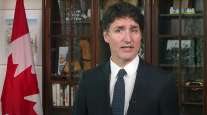This Obscure NAFTA Chapter Could be Canada’s Deal-Breaker Again

On Oct. 1, 1987, days before the U.S. and Canada signed their biggest-ever trade deal, then-Prime Minister Brian Mulroney shocked the Americans by walking away from the negotiating table.
It was a high-stakes gamble designed to ensure the Free Trade Agreement contained a dispute-settlement mechanism — what Mulroney called his essential condition — that would give Canada a way to resolve trade conflicts outside U.S. courts. The David-and-Goliath move worked, and two days later the countries reached an agreement.
Fast forward 30 years, and Justin Trudeau, the current prime minister, is arriving at the same crossroads as his predecessor. The U.S. confirmed last week that among its top objectives in upcoming negotiations on the North American Free Trade Agreement — which superseded the FTA in 1994 — is the elimination of the Chapter 19 dispute-resolution mechanism that Mulroney went to such lengths to preserve.
Will it be the deal breaker it was in 1987?
“Things like getting rid of Chapter 19 dispute-settlement panels, that’s not a small bean. That’s a biggie,” Derek Burney, Mulroney’s chief of staff during the FTA talks and a key player in NAFTA negotiations, said in a telephone interview last week. “We wouldn’t have the trade agreement if we didn’t get that dispute settlement.”
Burney also zeroed in on why the Canadian side was willing to risk so much to get the mechanism into the FTA: “We don’t trust their trade-remedy tribunals, we never have.”
The first round of NAFTA renegotiations begins on Aug. 16, with representatives from the U.S., Canada and Mexico gathering in Washington. President Donald Trump has threatened to withdraw from NAFTA if Mexico and Canada don’t agree to more favorable terms for the U.S.
NAFTA’s Chapter 19 dispute-resolution mechanism allows review by independent, binational panels — instead of judicial review by domestic courts — in anti-dumping and countervailing duty cases. Since NAFTA came into force, Canada has been involved in about 73 panels over items such as cattle, magnesium, hot-rolled steel, color-picture tubes, greenhouse tomatoes and super-calendered paper, according to the website of the NAFTA Secretariat, which is responsible for managing Chapter 19 proceedings.
But given that in the last decade Canada has only initiated three cases under the provision, Robert Wolfe, professor emeritus at Queen University’s School of Policy Studies in Kingston, Ontario, questions whether Chapter 19 is essential. Wolfe suggests Canada may want to consider bluffing, and when push comes to shove, give in on Chapter 19 in exchange for something better, gaining concessions on Trump’s Buy American rules, for example, which restrict the ability of Canadian companies to bid on U.S. government contracts.
“If you had to choose between a real restraint on Buy American and keeping Chapter 19, I’d yell and pound the table and give up Chapter 19,” Wolfe said. “A lot more Canadian jobs might benefit from stopping discriminatory government procurement in the U.S.”
Wolfe says cross-border supply chains are much more prevalent, and a company that is part of such an arrangement would be shooting itself in the foot by taking a trade-remedy action against its partner. He cites the motor vehicle industry, saying “you’re not going to see anti-dumping between Canada and the U.S.,” because the bits and pieces of the cars go back and forth over the border so many times.
Chad Bown, senior fellow at the Washington-based Peterson Institute for International Economics, said in a July 19 report the Trump administration’s goal under NAFTA negotiations is to make it easier to restrict imports from Canada and Mexico. That’s “worrisome” because it could eliminate any new trade liberalization gains or reverse previous inroads, and likely lead to a situation where Canada and Mexico respond in kind against U.S. exports.
By 2016, only 1.3% of imports from NAFTA partners were covered by U.S. anti-dumping and countervailing duties versus 9.2% of Chinese imports and 2.7% of imports from the rest of the world, Bown wrote. He predicts Trump’s barriers could more than quintuple the level of Canadian imports covered by trade remedies to 6.6%. Without safeguards such as Chapter 19, the Trump administration’s NAFTA “could make U.S. trade with Canada and Mexico much less free.”
NAFTA, which many people thought would lead to widespread job losses, is now much more popular in Canada than the other two countries. A Pew Research survey found 76% of Canadian respondents felt the pact has benefited their country, versus 60% of Mexicans and 51% of Americans.
NAFTA is also credited with having had measurable and positive impacts on everything from trade flows and investment to employment and productivity. A 2014 study on the effects of NAFTA by the Peterson Institute estimates Canada is about $50 billion richer each year in additional gross domestic product because of expanded two-way trade under NAFTA.
That may give Trudeau an advantage over his U.S. and Mexican counterparts. The status quo in many respects works just fine, whereas Trump may be under pressure to deliver a quick victory, and the Mexicans are said to want to wrap up negotiations before NAFTA becomes a battleground in summer 2018 presidential elections.
“Canada walking away is the worst-case scenario,” Wolfe said. “We don’t want to have to do that, and we don’t want President Trump to rip the thing up. They’re a bigger boy in the school yard than we are, but we don’t have to think we’re going to get pushed around. We do have leverage.”
David MacNaughton, Canada’s ambassador to the U.S., said at a forum last week that it makes sense to have some kind of dispute-resolution mechanism within the agreement but the current one could be improved. A spokesman for Chrystia Freeland, Canada’s minister of foreign affairs, declined to comment on the dispute-resolution mechanism.
Mulroney fought so hard to preserve the dispute settlement because without it, he reasoned, Canada would face years of litigation in the U.S. court system whenever a disagreement arose. That’s why he took the extraordinary step in 1987 of calling his chief negotiator in Washington to tell him to pack his bags and come home.
“I instructed Simon Reisman to return, and used it as a manner of getting the attention of the American government big time,” Mulroney said in a 2011 interview. “That happened, and I think it led to the resolution of the impasse and the Free Trade Agreement.”
Burney, who the government has reached out to for advice as it prepares for a new round of talks, has called on Canada to start drawing lines in the sand and spell out what it’s not willing to compromise on. Trudeau’s government has so far been publicly quiet on its NAFTA priorities. If push comes to shove, Trudeau may need to channel Mulroney, who has acted as his informal adviser in dealing with the Trump administration.
“You’ve got to be able to walk away from the table. Otherwise you don’t go to the table,” John Manley, chief executive of the Business Council of Canada, said in a recent interview. “Canada needs to stand firm on dispute settlement, otherwise we’re sitting ducks.”




